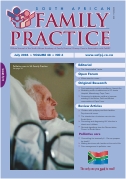updAIDS in SA Family Practice - Preventing and diagnosing HIV infection in infants and children
Abstract
The world’s two billion children and adolescents are at the centre of the HIV/AIDS crisis. Today, more than half of all new HIV infections affect people under the age of 25. Girls are hit harder and younger than boys. Infant and child death rates have risen sharply, and 14 million children are now orphans because of the disease. And yet the young offer the greatest hope for defeating the epidemic. To make healthy and informed choices they need knowledge and life skills, youth-friendly and gender-sensitive services and a protective familial, social and legal environment. The children of this world deserve proactive programmes to prevent mother-to-child transmission of HIV, and care, protection and support. Currently, only 5% of HIV-positive children in developing countries receive the treatment they need. Ann Veneman, executive director of Unicef, recently said: “Children are the missing face of HIV/AIDS, and Dean Hirsch, chairman of the Global Movement for Children, said the lack of treatment amounted to a death sentence for millions of children. He warned that most HIV-positive children die before their fifth birthday. Providing an HIV-infected pregnant woman with comprehensive care can reduce the risk of transmission to less than 2%, but not even 10% of HIV-positive pregnant women currently receive the necessary drugs. Thomas Miller, chief executive officer of Plan International said: “Unless the world takes urgent account of the specific impact AIDS has on children, we will fail to meet the Millennium Development Goal - to halt and begin to reverse the spread of the disease by 2015. In response to these calls for action, the next four updAIDS columns will be dedicated to aspects concerning the prevention and comprehensive care of HIV exposed infants and children. SA Fam Pract Jul 2006;48(6):34-41
Issue
Section
CPD
By submitting manuscripts to SAFP, authors of original articles are assigning copyright to the South African Academy of Family Physicians. Copyright of review articles are assigned to the Publisher, Medpharm Publications (Pty) Ltd, unless otherwise specified. Authors may use their own work after publication without written permission, provided they acknowledge the original source. Individuals and academic institutions may freely copy and distribute articles published in SAFP for educational and research purposes without obtaining permission.

